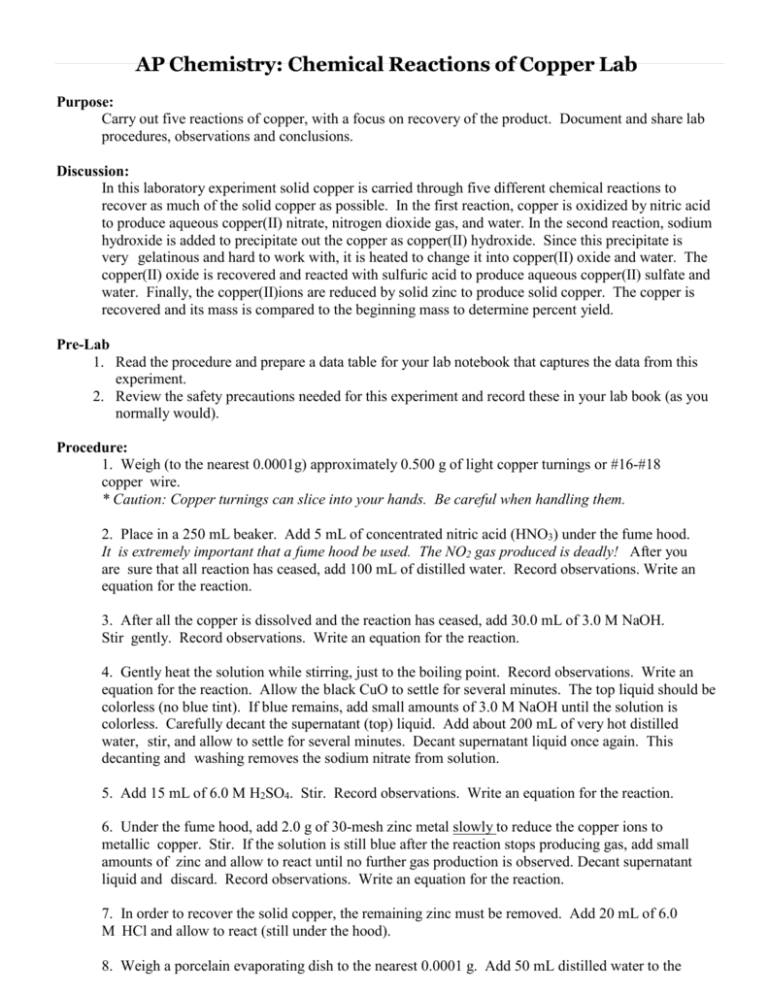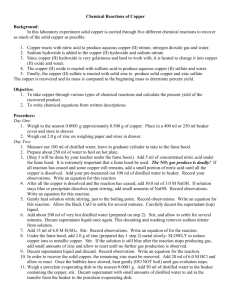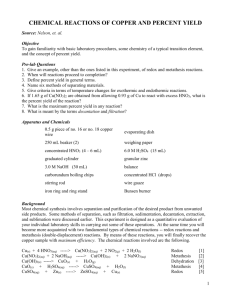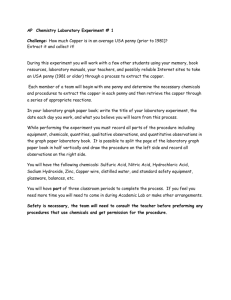AP Chemistry: Chemical Reactions of Copper Lab - MHS
advertisement

AP Chemistry: Chemical Reactions of Copper Lab Purpose: Carry out five reactions of copper, with a focus on recovery of the product. Document and share lab procedures, observations and conclusions. Discussion: In this laboratory experiment solid copper is carried through five different chemical reactions to recover as much of the solid copper as possible. In the first reaction, copper is oxidized by nitric acid to produce aqueous copper(II) nitrate, nitrogen dioxide gas, and water. In the second reaction, sodium hydroxide is added to precipitate out the copper as copper(II) hydroxide. Since this precipitate is very gelatinous and hard to work with, it is heated to change it into copper(II) oxide and water. The copper(II) oxide is recovered and reacted with sulfuric acid to produce aqueous copper(II) sulfate and water. Finally, the copper(II)ions are reduced by solid zinc to produce solid copper. The copper is recovered and its mass is compared to the beginning mass to determine percent yield. Pre-Lab 1. Read the procedure and prepare a data table for your lab notebook that captures the data from this experiment. 2. Review the safety precautions needed for this experiment and record these in your lab book (as you normally would). Procedure: 1. Weigh (to the nearest 0.0001g) approximately 0.500 g of light copper turnings or #16-#18 copper wire. * Caution: Copper turnings can slice into your hands. Be careful when handling them. 2. Place in a 250 mL beaker. Add 5 mL of concentrated nitric acid (HNO3) under the fume hood. It is extremely important that a fume hood be used. The NO2 gas produced is deadly! After you are sure that all reaction has ceased, add 100 mL of distilled water. Record observations. Write an equation for the reaction. 3. After all the copper is dissolved and the reaction has ceased, add 30.0 mL of 3.0 M NaOH. Stir gently. Record observations. Write an equation for the reaction. 4. Gently heat the solution while stirring, just to the boiling point. Record observations. Write an equation for the reaction. Allow the black CuO to settle for several minutes. The top liquid should be colorless (no blue tint). If blue remains, add small amounts of 3.0 M NaOH until the solution is colorless. Carefully decant the supernatant (top) liquid. Add about 200 mL of very hot distilled water, stir, and allow to settle for several minutes. Decant supernatant liquid once again. This decanting and washing removes the sodium nitrate from solution. 5. Add 15 mL of 6.0 M H2SO4. Stir. Record observations. Write an equation for the reaction. 6. Under the fume hood, add 2.0 g of 30-mesh zinc metal slowly to reduce the copper ions to metallic copper. Stir. If the solution is still blue after the reaction stops producing gas, add small amounts of zinc and allow to react until no further gas production is observed. Decant supernatant liquid and discard. Record observations. Write an equation for the reaction. 7. In order to recover the solid copper, the remaining zinc must be removed. Add 20 mL of 6.0 M HCl and allow to react (still under the hood). 8. Weigh a porcelain evaporating dish to the nearest 0.0001 g. Add 50 mL distilled water to the beaker containing the copper, remove from the hood and stir. Decant supernatant liquid and transfer the entire solid to the weighed evaporating dish. You may wash with small amounts of distilled water to aid in this transfer. Add 10 mL distilled water to the solid, stir, and decant supernatant liquid. Repeat this washing two more times. 9. Wash the solid with 5 mL of acetone (Keep away from flames!), decant supernatant liquid and discard in labeled organic waste container. 10. Evaporate the remaining acetone by placing the evaporating dish on a hot plate. Stir the solid occasionally while drying. Cool the evaporating dish and weigh. Results: You will present this lab in one of the following ways: Powerpoint presentation o If you choose this option, your powerpoint should include pictures of reactants, products and intermediate steps for each reaction, as well as descriptions of what you observed. You will also write out each reaction as detailed in the lab and calculate your percent yield of copper. You will include a summary and conclusion slide as well, stating objectives that were completed, those that were incomplete, a discussion of your percent yield and any improvements or changes you would make to the lab. You may turn in your lab as an e-mail, shared as a google doc, or on a flash drive. Please save your file as [last name partner 1_last name partner 2_CopperLab]. Video file o If you choose this option, you will video the progress of your lab, with commentary. You will include written equations and calculations of percent yield with your video. You will include a verbal or written discussion stating objectives that were completed, those that were incomplete, a discussion of your percent yield and any improvements or changes you would make to the lab. Compile the video into a file and share it with google docs or bring it on a flash drive. Please save your file as [last name partner 1_last name partner 2_ CopperLab]. Experimental journal with photos o This option will be a written description of what you saw during the lab. You must be very detailed and comment on each reaction that occurred. You will include written equations as described in the procedures and calculations of percent yield. You will also provide a written portion stating objectives that were completed, those that were incomplete, a discussion of your percent yield and any improvements or changes you would make to the lab. You will turn in one journal per partner group, with both student’s names on a cover sheet. **Please note: Extra effort with be rewarded! Wow me!






